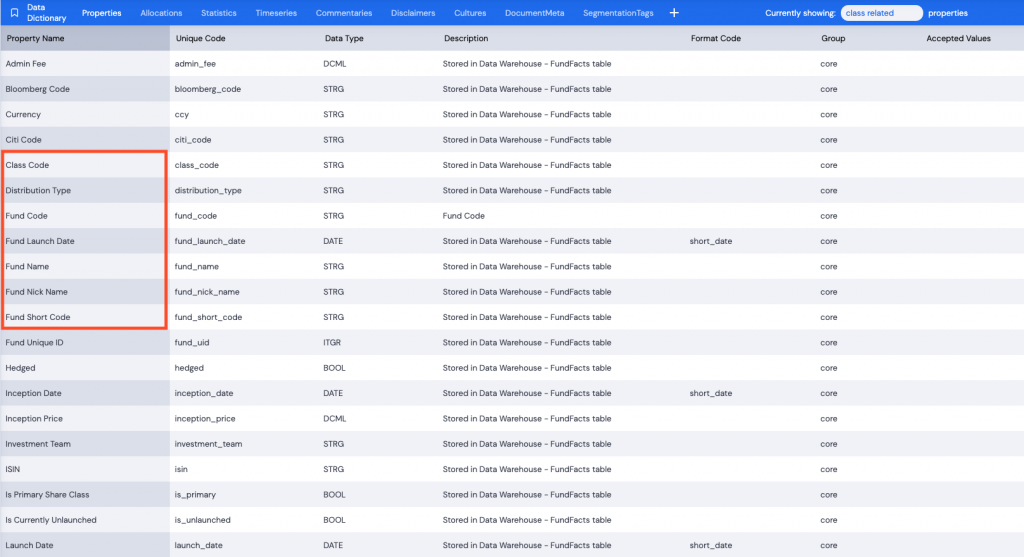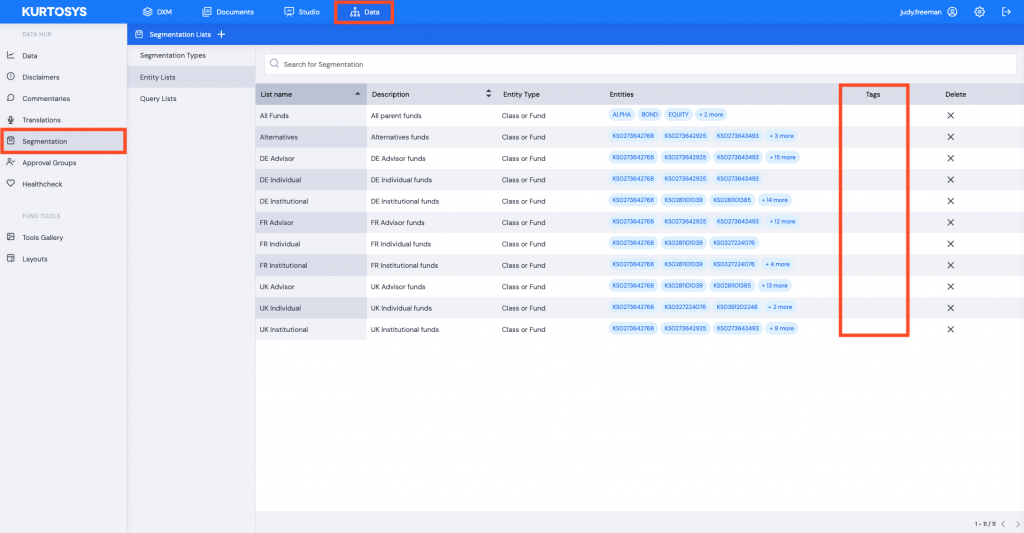Data Dictionary
The Data Dictionary is the space in which you build the structure for the database that will hold all your data properties, Entity related properties, Statistics, Commentaries, Disclaimers, Cultures, etc. It provides a framework for your data architecture. This makes it easier for data to be correctly stored when it is uploaded and to be accurately retrieved when it is called. The Data Dictionary is fully customizable meaning that it can be configured for any type of data as per a business’s needs. Data Dictionary items cannot be deleted, or removed from the system, data therefore must always match the correct structure, and adding new data types is easily achieved. Data Names and Unique Codes tend to have the same name, but the Unique Code is always written snake case with underscores in place of spaces. E.g. Admin Fee becomes admin_fee.
Properties
Properties Data is associated with the various Entity types. Fund, Class, Account or Benchmark.

The data that is entered provides descriptive information regarding the entity. For example, a Class would have a Class Code, a related Fund Code, Fund Name, Fund Launch Date, etc.

Every piece of Properties information has various fields attached to it; a Property Name (label), a Unique Code (code), a Data Type, a Description, Format Code (how it will display), Group (no longer used but is still populated as “core”), and Accepted Values. Not all fields are mandatory.
Allocations
Allocations properties are usually used for a spread of data that would be used in a table, chart or graph for displaying how a fund’s assets are allocated. For example, Geographic Breakdown would display data showing the geographic distribution of a fund.

Allocations Data items are associated with entity types: Class, Fund, Account or Benchmark and each one has a Property Name (label), Unique Code (code) and Description attached. Not all fields are mandatory. Only Property Name, Unique Code and Description are displayed for Allocations.
Statistics
Statistics properties are usually used for displaying a series of data like Daily Price Stats or Financial Ratios in charts, graphs or tables.

Statistics data items are associated with entity types: Class, Fund, Account or Benchmark and each one has a Property Name, Unique Code and Description attached. Not all fields are mandatory. Only Property Name, Unique Code and Description are displayed for Statistics.
Timeseries
Timeseries properties are used for displaying data in graphs, tables or charts, usually reflecting a measurement over a period of time, for example, Fund Prices, or Cumulative Performance.

Timeseries data items are associated with entity types: Class, Fund, Account or Benchmark and each one has various fields attached like Property Name (label), Unique Code (code) and Description. Not all fields are mandatory.
Commentaries
Commentaries are used for creating excerpts or paragraphs of text which will be inserted into a document or website. They are attached to Approval Groups. Approval groups contain Users with specific roles who have the authority to sign off on wording used in Commentaries; for example, a Marketing approval group could sign off on the text for an Investment Objective. After a Commentary is drafted, it is assigned to the appropriate group for approval, a member of the group will then need to sign off on it i.e. accept the text that has been written. This is all done in the Kurtosys App.

Commentaries can be associated with different entity types: Class, Fund, Account or Benchmark. Fields used for commentaries include Commentary Type, Description and Approval Group. Not all fields are mandatory.
Disclaimers
Disclaimers are used for creating excerpts or paragraphs of text which will be inserted into a document or website. They are attached to Approval Groups. Approval groups contain Users with specific roles who have the authority to sign off on wording used in Disclaimers; for example, a Compliance or Legal approval group could sign off on the text for a Fees disclaimer, giving legal approval of wording and information. After a Disclaimer is drafted, it is assigned to the appropriate group for approval, a member of the group will then need to sign off on it i.e. accept the text that has been written. This is all done in the Kurtosys App.

Disclaimers can be associated with different entity types: Class, Fund, Account or Benchmark. Fields used for Disclaimers include Disclaimer Type, Description and Approval Group. Not all fields are mandatory.
Cultures
Cultures relate to the various languages and jurisdictions for which reports are required for an entity. For example, a French company might want their website and documentation available in French and English whereas a Swiss company might want their website and documentation in Swiss, German, Italian, French and English. A Belgian company may want a report in Belgian-English based on country specific regulations for that jurisdiction.

When a client instance is set up, the required cultures are included so that the Translations table will provide for any wording in any of their selected languages. It is mandatory to select a Default Culture for any instance.

DocumentMeta
Document Meta refers to the data category or type attached to a particular document for example, the ISIN, Language or Document Type.

SegmentationTags
Segmentation Tags are created for tagging additional data that wouldn’t be included in standard entity properties data. They are used mostly to automate workflows in the Document Production Center. It is not always necessary to create Segmentation Tags; they are only used when standard entity properties data doesn’t cover all meta data requirements e.g. report dates or document type meta data required for document production, but not provided as an entity property.

There is, however, a column ready for Tags in the Data | Segmentation | Segmentation List table.

